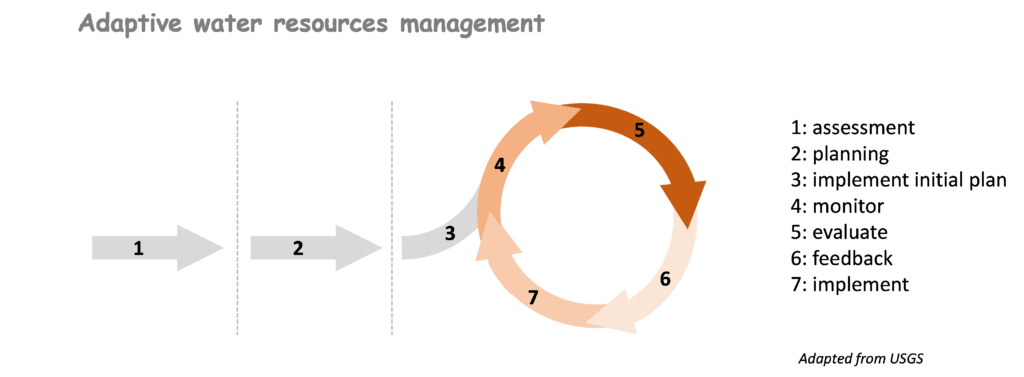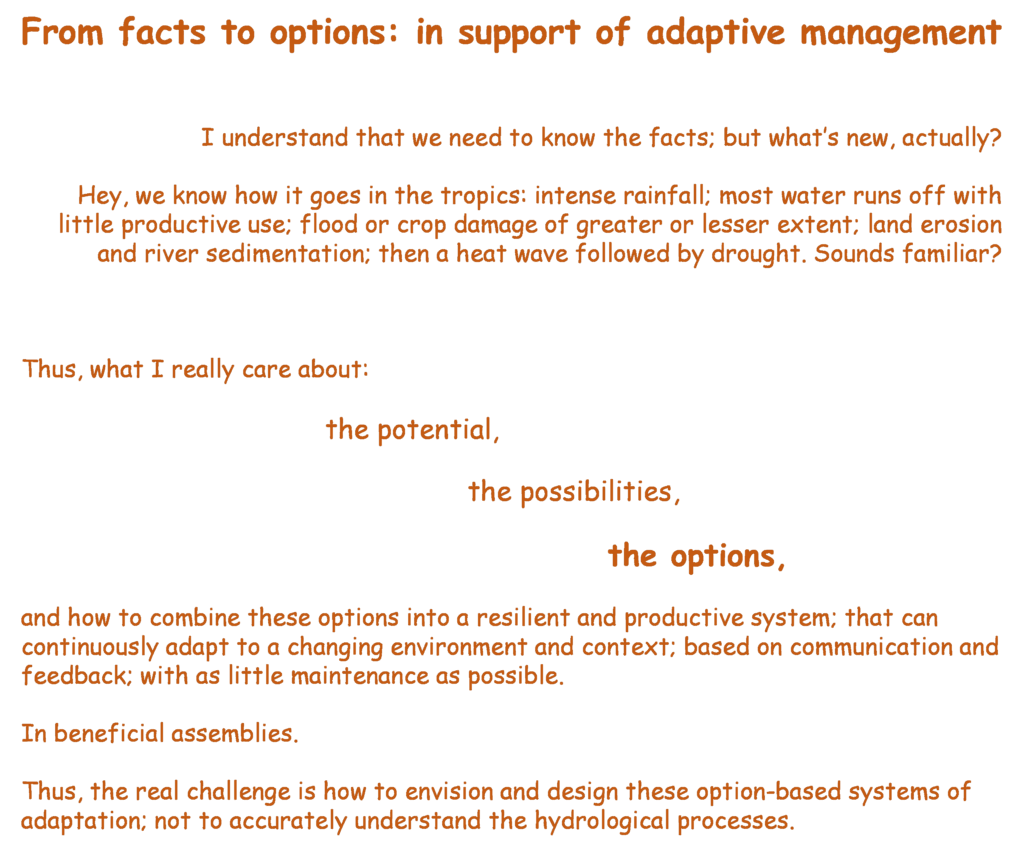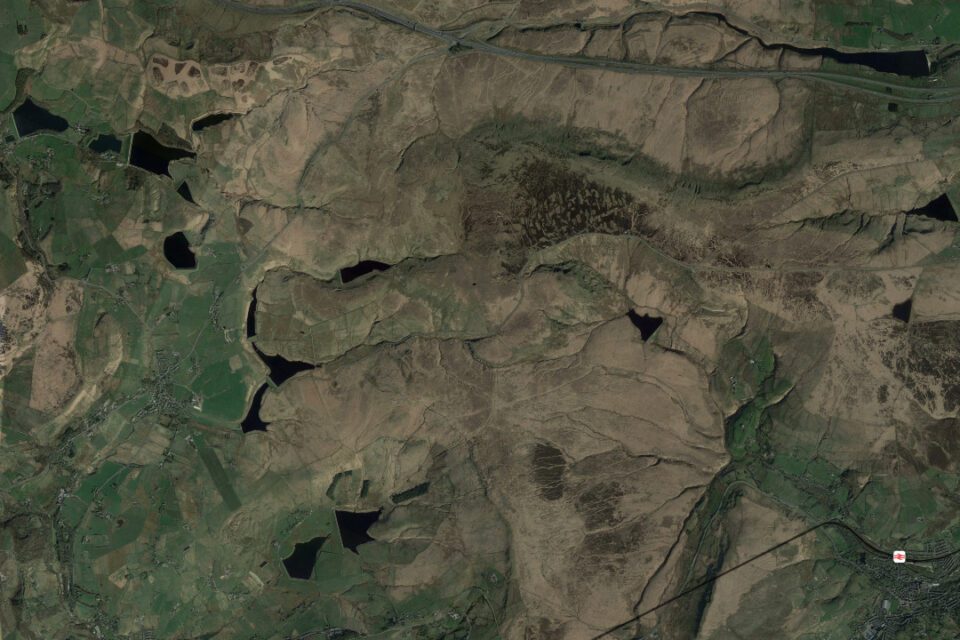Water managers generally make a huge effort to quantify and model the hydrological processes. But how useful is this? Are there better ways to expend their time & energy? Some thoughts.
Hydrology is an inexact science
To start with, hydrology is an inexact science. What happens to a raindrop once it reaches the land surface is a function of many parameters that include rainfall regime, soil type, geology, vegetation, land use, relief, and many others. Most of these parameters are subject to high spatial variability. Parameters can change from one plot to another, or even within a plot. Some change from season to season. In addition, human interactions with the landscape—from agricultural activities to urbanization and deforestation—continuously change the attributes of many of these parameters. Thus, it is virtually impossible to come up with an accurate representation of the hydrological processes. Moreover, climate change is adding a whole new dimension to the uncertainties involved (note that the impacts of climate change are non-linear).
In summary: we have inadequate understanding of the hydrological processes and in fact barely know what is going on in a watershed. It is an epistemological problem; I do not think this will change.
Nevertheless, a statistical analysis of the hydrological parameters at larger scale is still useful. The general heterogeneity of the landscape and the uneven spatial (and temporal) distribution of the main hydrological drivers at this (regional/large) scale will smooth out extreme responses and mask some of the uncertainties and unknowns. It results in a response that is characterized by limited amplitude and skewness and can be used with appropriate caution. At smaller scales, however, this is not the case. Here we must accept that we, in fact, cannot really quantify the hydrological processes, and certainly not the extremes.
What are the implications?
For smaller catchments—where we do not really know the depth of the drought or height of the flood we need to prepare for—standard water resources management practices have limited applicability. Water permits and allocation formulas that distribute and optimize resource use may work in an average year but instantly fail in an extreme year. Hence, this management approach is incomplete. It does little in a non-average or extreme year—when it actually matters—to prevent damage or system collapse.
Something more is needed.
“Optionality is a substitute for full understanding (Nicholas Nassim Taleb)”
Nicholas Taleb suggests that maintaining optionality—thus, have a variety of ways to adapt or respond to an unexpected event—is an effective approach to prepare for a context that you do not fully understand or control. Optionality strengthens resilience. It also facilitates adaptive management.
Adaptive management
Adaptive management is “an intentional approach to making decisions and adjustments in response to new information and changes in context.” (Source: USAID)

One may argue that, given enough time, all management will adapt to a changing environment. Operating procedures will then change accordingly. But this is not what is meant by ‘adaptive management’.
Adaptive management is characterized by a systematic process to improve management practices based on constant feedback and continuous learning. It accepts that water management is complex—because of the multitude of interactions with the environment and socio-economic sectors—and that it cannot be simplified to an easy formula that is applicable under all or most circumstances. After all, environmental and socio-economic conditions change and are subject to uncertainty. Hence appropriate management practices are emergent, and constant adaptation—i.e. finding a better fit with the contextual environment—is a purpose in itself rather than a response to an inevitability. But how to do this in practice?
What is not the answer—in my view—is more data, more modeling, and more involvement of water agency staff. At least not at smaller scales. We simply do not have the budgetary resources for this. Moreover, such heavy-handed management approach is probably unworkable and could very well be rejected by stakeholders.
Instead, the starting point for adaptive management—in an iterative process based on continuous feedback—is to create a diverse set of options of all types and scales. How this wide pallet of options is used will depend on the conditions and associated water issues and is best determined through active involvement of low-level managers with direct interactions with immediate stakeholders. Following this line or reasoning, the best options are probably small ones, where feedback from actors at the lowest possible level can be received and taken into consideration. It facilitates a quicker learning process.
Optionality strengthens resilience; it also facilitates adaptive management
The above approach requires a good conceptual understanding of the hydrological processes and the landscape functions on which the agricultural sector—the dominant water user—depends. However, this approach does not require detailed knowledge of the hydrological parameters. As discussed above, we simply do not have this understanding.
Building blocks of adaptive water resources management
- A sound conceptual understanding of the hydrological processes and landscape functions
- Careful observation of what is going on in a watershed
- An understanding of the potential of the landscape
- A wide pallet of options; diverse and of all sizes
- Preferably a collection of small options—and those that do not require maintenance
- “Trial and small error”; learn from small mistakes; avoid big mistakes
- Preferably options that mimic nature—or provide nature-based solutions
- Options organized in beneficial assemblies—because they are more sustainable
- Avoid optimization or living on a razor’s edge; rather, create redundancies (which constitute ‘options’)
- Time, an important asset
- Decentralized management (emancipation & quicker response)
- Constant feedback from water users and landscape managers (incl. farmers)
- Acceptance of not fully understanding the hydrological processes and landscape and that constant adjustment of management practices is inevitable
- Constant learning (hint: no quick turn-over of landscape and water managers); note that learning requires constant feedback
- An open mind; to identify emerging solutions
- Cognitive diversity, since a comprehensive picture of the complex and multi-facetted water resources and landscape functions is required
- Etc.
Adaptive management depends on the capacity to learn; hence it requires constant feedback
Closing Remarks
This text advocates a management approach that moves away from (ever more) data, studies, and hierarchical water resources plans. Instead, it is based on a sound conceptual understanding of the environmental context in combination with a diverse set of options that are employed in ever changing ways based on constant feedback and adjustment.
The practical application of this approach will to some extent depend on the scale of the catchment. It is more feasible for small catchments, less so for very large ones.
The advantage of the approach are multifold: it is cheaper, less complex, less data intensive, more effective, more resilient, responds quicker to new conditions, creates ownership, leads to more sustainable solutions, etc..
The approach, therefore, addresses three key constraints in water management: 1) we never have adequate budget for water resources management, 2) we never fully understand the hydrological processes, and 3) we must adapt to a changing and more volatile climate.
Today’s climate is probably milder and more benign than what we will get in a few decades
Of course, it will be a challenge to convince administrators (and taxpayers) to invest in options whose eventual role is note yet fully understood. Spending public funds wisely is a legitimate concern. But the approach itself seems promising and deserves a closer look.

REFERENCES
Charles Massy, Call of the Reed Warbler: A New Agriculture, a New Earth; 2017
Arnold Cornelis, De Vertraagde Tijd, Revanche van de Geest als Filosofie van de Toekomst, 1999
Keith Beven, Breakthroughs in Uncertainty Estimation; 3 Oct 2013; https://www.youtube.com/watch?v=dC8I9PD8V5A
“The world will be what we make it” (US Fifth National Climate Change Assessment, NASA)
